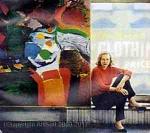Grace Hartigan
Grace Hartigan
Place: Newark
Born: 1922
Death: 2008
Biography:
Grace Hartigan was a second-generation American Abstract Expressionist painter and a member of the New York School.
Born in Newark, New Jersey, of Irish-English descent, Hartigan was the oldest of four children. Encouraging her romantic fantasies, her father and grandmother often sang songs and told her stories. Her mother, however, disapproved. At seventeen she was married to Robert Jachens. A planned move to Alaska, where the young couple planned to live as pioneers, ended in California, where Hartigan began painting with her husband's encouragement. After her husband was drafted in 1942, Hartigan returned to New Jersey to study mechanical drafting at the Newark College of Engineering. She also worked as a draftsman in an airplane factory to support herself and her son. During this time, she studied painting with Isaac Lane Muse. Through him, she was introduced to the work of Henri Matisse and Kimon Nicolaïdes’s The Natural Way to Draw, which influenced her later work as a painter.
Said Hartigan of her foray into painting, “I didn’t choose painting. It chose me. I didn’t have any talent. I just had genius.”
In 1945, Hartigan moved to New York City, and quickly became a member of the downtown artistic community. Her friends included Jackson Pollock, Larry Rivers, Helen Frankenthaler, Willem de Kooning and Elaine de Kooning, Frank O'Hara, Knox Martin, and many other painters, artists, poets and writers. Hartigan gained her reputation as part of the New York School of artists and painters that emerged in New York City during the 1940s and 1950s. Hartigan was selected by Clement Greenberg and Meyer Schapiro for the New Talent exhibition at Koontz Gallery in New York in 1950.
She was often thought of as a “second generation Abstract Expressionist”, being heavily influenced by her colleagues of the time. Her early career was characterized by experiments with total abstraction, as seen in the work Six by Six (1951) currently in the collection of the Frances Lehman Loeb Art Center in Poughkeepsie, NY. Beginning the early fifties Hartigan began to incorporate more recognizable motifs and characters into her paintings. Also during this time, she briefly exhibited under the name George Hartigan in an attempt to achieve greater recognition for her work.
Paintings from the Old Masters: In the early 1950s Grace Hartigan began painting figuratively from old master paintings. Clement Greenberg, an influential art critic in New York during the mid 20th century, enthusiastically supported Hartigan's Abstract Expressionist works, but opposed her painting figuratively. This discord resulted in her break from Greenberg. Painting from the old masters fostered Hartigan's growth in depicting space, light, form, and structure. Some examples of these paintings are Hartigan's River Bathers (1953), Knight, Death, and Devil (1952), and The Tribute Money (after Rubens) (1952), working after Matisse, Durer, and Rubens, respectively.
Brides: In 1949, Hartigan rented a studio on Grand Street in lower Manhattan. Inspired by the display windows of the numerous bridal shops concentrated on the street, Hartigan (with two unsuccessful marriages behind her) began to paint groups of mannequins dressed in bridal gowns. Grand Streets Brides (1954; Whitney Museum of American Art), based on Goya's Carlos IV of Spain and His Family (1800), was one of several works that drew the attention of critics and collectors and established her reputation. Later in her career, Hartigan said, " bridal theme is one of my empty ritual ideas ... it just seems ludicrous to me to go through all that fuss." Additionally, she stated, "I paint things that I'm against to try to make them wonderful ... very often."
Oranges: In November 1952, Hartigan and close friend Frank O'Hara began a collaborative project: Oranges. O'Hara had written a collection of fourteen poems while a student at Harvard. Hartigan created a painting in response to each of the fourteen poems, incorporating text from each poem into every image.
Memorials: Over the course of her career, Hartigan painted abstract compositions commemorating the deaths of friends and family members, including Martha Jackson, Franz Kline, Frank O'Hara, her father, and Winston Price.
Marilyn (1962): In the year of the actress' death, Hartigan painted an image of Marilyn Monroe. Her painterly, expressive treatment of the subject differs from the impersonal manner of such pop artists as Andy Warhol. Working from several photographs, Hartigan felt that her fragmented, semi-abstract picture represented Monroe more honestly than her glamorous, public image.
Reisterstown Mall (1965): Grace returned to her lifetime fascination with shop windows with an updated, modern vision. She began working her way back to more recognizable imagery, though keeping the objects floating in an abstract, buoyant, circular composition. Though she includes a plethora of recognizable objects, this is not Pop Art. Grace was "always too passionately involved with her subject matter to accept the deadpan perspective of Pop."
More...
Wikipedia link: Click Here














